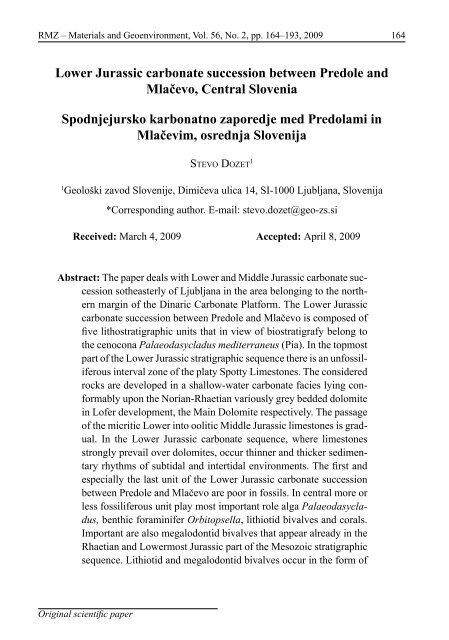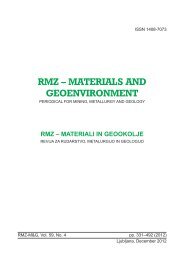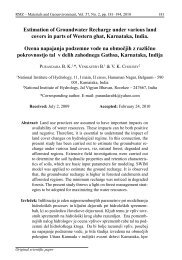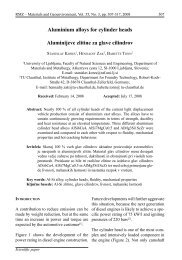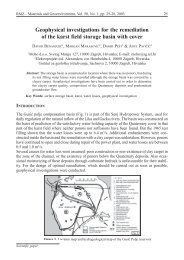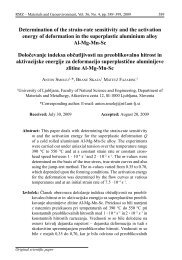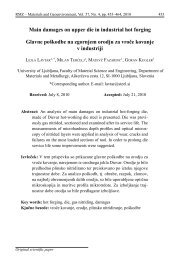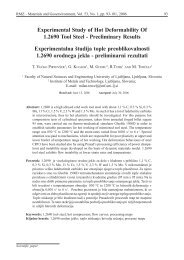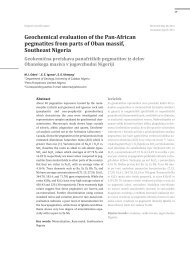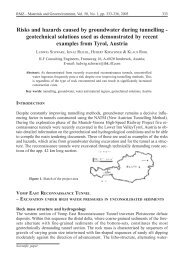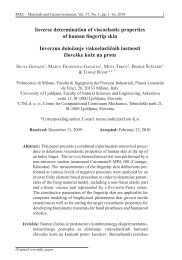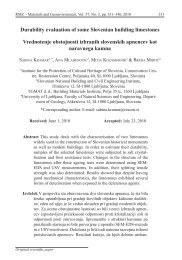Lower Jurassic carbonate succession between Predole and ... - RMZ
Lower Jurassic carbonate succession between Predole and ... - RMZ
Lower Jurassic carbonate succession between Predole and ... - RMZ
You also want an ePaper? Increase the reach of your titles
YUMPU automatically turns print PDFs into web optimized ePapers that Google loves.
<strong>Lower</strong> <strong>Jurassic</strong> <strong>carbonate</strong> <strong>succession</strong> <strong>between</strong> <strong>Predole</strong> <strong>and</strong> Mlačevo, Central Slovenia168division of the <strong>Jurassic</strong> stratigraphicsequence in Dinarides. Do z e t (1999a, b) explored <strong>and</strong> described <strong>Lower</strong><strong>Jurassic</strong> shallow-water <strong>carbonate</strong> <strong>succession</strong>with coal on the Dinaric CarbonatePlatform in Southern Slovenia.The coal occurs in the form of lenses<strong>and</strong> thin seams among the limestone<strong>and</strong> dolomite beds of middle part of the<strong>Lower</strong> <strong>Jurassic</strong> age. Mi l e r <strong>and</strong> Pav š i č(2008) described the development ofthe Triassic <strong>and</strong> <strong>Jurassic</strong> beds in theKrim Mountain area. The <strong>Jurassic</strong>stratigraphic sequence involves <strong>Lower</strong><strong>and</strong> Middle <strong>Jurassic</strong> shallow marine<strong>carbonate</strong> rocks.Mat e r i a l s a n d m e t h o d sapplied. For formation analaysis thecross-section Spodnja Slivnica-<strong>Predole</strong>has been chosen (St r o h m e n g e r &Do z e t, 1991). Around 150 samples of<strong>carbonate</strong> rocks have been collectedalong the road on the southeastern borderof Radensko polje <strong>and</strong> another 65rock samples in the cross-section Ilovagora-Čušperk for micropaleontologicalanalyses carried out by Rajka Radoičić<strong>and</strong> S. Dozet.Carbonate rocks are classified accordingto Fo l k’s (1959) practical petrographicclassification of limestones <strong>and</strong>Du n h a m’s (1962) classification of <strong>carbonate</strong>rocks according to depositionaltexture.This work is based on data, obtainedduring the systematic regional geologicmapping in the field on the MapSheet Grosuplje for elaboration of GeologicMap of Slovenia on the scale of1 : 50 000, performed by GeologicalSurvey of Slovenia. During geologicmapping of Central Slovenia we werefocused on stratimetric researches inthe field <strong>and</strong> systematic labor examinations.For planning of geologic mappingon the Map Sheet Grosuplje theBasic Geologic Map of SFRJ – MapSheet Ribnica on the scale of 1:100000 <strong>and</strong> its Explanatory text has beenRe s u lt s o f t h e r e s e a r c h w o r k<strong>Lower</strong> <strong>Jurassic</strong>In the area <strong>between</strong> Spodnja Slivnica<strong>and</strong> Račna (Figure 2) five litostratigraphicunits of the <strong>Lower</strong> <strong>Jurassic</strong> ageis separated. Superpositionally frombottom to top they follow one otherlike that: 1 – bedded micritic <strong>and</strong> oolitic-oncoliticlimestones, 2 – beddedOrbitopsella Limestones, 3 – beddedLithiotis Limestones, 4 – bedded tomassive oolitic <strong>and</strong> reef limestones, 5– platy Spotty Limestones.<strong>RMZ</strong>-M&G 2009, 56
<strong>Lower</strong> <strong>Jurassic</strong> <strong>carbonate</strong> <strong>succession</strong> <strong>between</strong> <strong>Predole</strong> <strong>and</strong> Mlačevo, Central Slovenia174Figure 5. Explanation<strong>RMZ</strong>-M&G 2009, 56
175 Do z e t, S.Figure 6. Grey bedded <strong>Lower</strong> <strong>Lower</strong> <strong>Jurassic</strong>micritic limestoneFigure 7. Bedded <strong>and</strong> b<strong>and</strong>ed <strong>Lower</strong> <strong>Lower</strong><strong>Jurassic</strong> micritic limestoneOolitic limestone interbeds are composedof ooids with radial microstructure<strong>and</strong> micritic ooids. They are boundwith fibrous <strong>and</strong> mosaic calcite cement.The oolitic limestones with radial ooidsoriginated in shoals with moderatelyagitated water (Ti š l j a r & Ve l i ć, 1991).Micritic ooids are the result of diageneticchanges, chiefly due to micritizationby Cyanophiceae <strong>and</strong> cryptocrystallinerecrystallization.Limestones of wackestone <strong>and</strong> mudstonetype were deposited in a shallowsubtidal environment in a restrictedpart of lagoon, while coarse-grainedsparitic limestones originated in anintertidal belt, what is proved by erosionalsurfaces, stromatolitic belts,fenestral structures <strong>and</strong> textures, intraclasts,shrinkage pores <strong>and</strong> intertidalbreccias.The lower unit of <strong>Lower</strong> <strong>Jurassic</strong> <strong>carbonate</strong>sequence is relatively poor infossils, what point at unfavourable lifeconditions for the then fauna <strong>and</strong> flora.Important characteristics of the oldestunit is especially an absence of echinoderms<strong>and</strong> rarity of foraminifers <strong>and</strong>molluscs (Figure 8). Limestones of thelowermost unit of <strong>Lower</strong> <strong>Jurassic</strong> <strong>succession</strong>contain the following fossils:Figure 8. Black bedded limestone withmegalodontid lumachelles, <strong>Lower</strong> <strong>Lower</strong><strong>Jurassic</strong>, Radensko poljePalaedasycladus mediterraneus (Pia)(Pl. 1, Fig. 1), P. elongatulus (Pratur-<strong>RMZ</strong>-M&G 2009, 56
<strong>Lower</strong> <strong>Jurassic</strong> <strong>carbonate</strong> <strong>succession</strong> <strong>between</strong> <strong>Predole</strong> <strong>and</strong> Mlačevo, Central Slovenia180The described oolitic limestones wereformed in an evironment with high-waterenergy, in shoals <strong>and</strong> bars respectively.In the limestones of the Oolitic Limestoneunit sections of alga Palaeodasycladusmediterraneus (Pia), rare foraminifersPseudocyclammina liassicaHottinger <strong>and</strong> Haurania deserta Henson,pointing at upper part of middle<strong>Lower</strong> <strong>Jurassic</strong> (Domerian) as well asrare fragments of crinoids, molluscs,corals, stromatoporoids <strong>and</strong> pelecypodPecten sp. were found.The Oolitic Limestone unit is foundin several places of central <strong>and</strong> southernSlovenia. In the oolitic-bioclasticlimestones, that lie above the LithiotisLimestone <strong>and</strong> are accordingly anequivalent of the Oolitic Limestoneunit of the <strong>Lower</strong> <strong>Jurassic</strong> stratigraphicsequence, a corral patch reef with richassociations of corals <strong>and</strong> stromatoporoidswere detected on Krim (Tu r n š e k& Ko š i r, 2000) <strong>and</strong> Trnovski gozd(Tu r n š e k et al., 2003). Tu r n š e k <strong>and</strong>Ko š i r (2000) described systematicallyseven coral species, from which threespecies are new: Thecactinastraea krimensisTurnšek, Siderosmilia perithecataTurnšek <strong>and</strong> Cuifastraea lopatensisTurnšek. Tu r n š e k et al. (2003)found in Trnovski gozd in the <strong>Lower</strong><strong>Jurassic</strong> patch reef, lying upon the LithiotisLimestone, a finding of <strong>Lower</strong><strong>Jurassic</strong> corals. Systematically weredetermined <strong>and</strong> described 12 coral speciesbelonging to eight genera. Fourspecies were new: Protoheterastraeatrnovensis Turnšek, Apocladophylliagozdensis Turnšek, Phacelophyllia bacariTurnšek <strong>and</strong> Heterostraea angelaeTurnšek. Corals built at least 70 meterslong <strong>and</strong> 4 meters large patch reef, thatgrew on the northern border of the DinaricCarbonate Platform. The coralsrange the <strong>Lower</strong> <strong>Jurassic</strong> reef limestoneof the Trnovski gozd in Upper Pliensbachian,Domerian respectively.The Domerian Oolitic Limestone originatedin shallow <strong>and</strong> open parts of theDinaric Carbonate Platform.The thickness of Uppermost Pliensbachianoolitic limestones ammountsfrom 15 to 25 meters.5 th Unit – Spotty Limestones, ToarcianThe youngest unit of considered <strong>carbonate</strong>sequence (Figure 16) is composedof medium dark grey, dark grey<strong>and</strong> grayish black, platy (predominate)<strong>and</strong> bedded prevalently micritic (mudstone)<strong>and</strong> pelmicritic bioturbatedlimestones, which are due to activity ofnumerous organisms, that ate mud, becamespotty. For the Spotty Limestones(Figures 3, 5) is also pretty characteristicthat they are poor in fossils. Theycontain only rare remains of algae, benthicforaminifers <strong>and</strong> echinoderms. Accordingto texture they are mostly mi-<strong>RMZ</strong>-M&G 2009, 56
181 Do z e t, S.critic, oomicritic <strong>and</strong> biomicritic limestones.In the limestones of the fifthunit locally a gently lamination can beobserved. The stratigraphic sequenceof Spotty Limestones include sporadicthinner interbeds of oolitic <strong>and</strong> bioclasticlimestones (crinoid limestones: Pl.2, Fig. 5).Plate 2. Fig. 1. Bioclastic-peloid packstone to grainstone with foraminifersOrbitopsella praecursor (Gümbel) Trochaminidae <strong>and</strong> Textulariidae,Middle <strong>Lower</strong> <strong>Jurassic</strong>, <strong>Predole</strong> at Račna; Fig. 2. Foraminifer Involutinafarinacciae Bronnimann & Zaninetti in an intrasparitic packstone, Middle<strong>Lower</strong> <strong>Jurassic</strong>, <strong>Predole</strong> at Račna; Fig. 3. Ooid grainstone with foraminiferInvolutina farinacciae Bronnimann & Zaninetti, Middle <strong>Lower</strong> <strong>Jurassic</strong>,<strong>Predole</strong> at Račna; Fig. 4. Alga Linoporella (Tersella ?) lucasi Cross& Lemoine coated with algal (cyanobacterial) envelope, Middle <strong>Lower</strong><strong>Jurassic</strong>, <strong>Predole</strong>; Fig. 5. Crinoid limestone: bioclastic-intraclastic packstone,Upper <strong>Lower</strong> <strong>Jurassic</strong>, <strong>Predole</strong> at Račna; Fig. 6. Recrystallized ooidmudstone with foraminifer Ophthalmidium sp., Upper <strong>Lower</strong> <strong>Jurassic</strong>/Dogger, <strong>Predole</strong> at Račna.<strong>RMZ</strong>-M&G 2009, 56
<strong>Lower</strong> <strong>Jurassic</strong> <strong>carbonate</strong> <strong>succession</strong> <strong>between</strong> <strong>Predole</strong> <strong>and</strong> Mlačevo, Central Slovenia182According to dark colour, abundant bituminousorganic matter, structures <strong>and</strong>texture <strong>and</strong> regarding the fauna (ostracods,molluscs with thin shells) <strong>and</strong>flora can be concluded that the SpottyLimestones were deposited in restrictedparts of shelf, where there were nofavorable conditions for greater diversityof organisms.The thickness of upper part of the <strong>Lower</strong><strong>Jurassic</strong> limestones varies from 55 mto 75 m.Midle <strong>Jurassic</strong>Figure 16. The contact <strong>between</strong> the underlyingmedium grey massive Middle <strong>Lower</strong><strong>Jurassic</strong> oolitic limestone <strong>and</strong> the verlyingdark platy Upper <strong>Lower</strong> <strong>Jurassic</strong> SpottyLimestoneUpper part of the <strong>Lower</strong> <strong>Jurassic</strong> limestonescontain rare foraminifers Hauraniadeserta Henson, Ophthalmidiumsp. (Pl. 2, Fig. 6), Pseudocyclamminasp., crinoids, small gastropods as wellas algae Aeolisaccus dunningtoni Elliot<strong>and</strong> Thaumatoporella parvovesiculifera(Raineri).The age of considered <strong>carbonate</strong> rocksis defined also by their stratigraphic position,since they lie <strong>between</strong> the <strong>Lower</strong><strong>Jurassic</strong> biostromal (coral) beds <strong>and</strong>dark oolitic limestones with diagnosticMiddle <strong>Jurassic</strong> fossils, so that they aresurely of Toarcian age.Hanging wall of the considered <strong>carbonate</strong><strong>succession</strong> is represented by astratigraphic sequence (Figure 4, 5) ofdark brownish grey to grayish blackoolitic limestones (ooid grainstones)that are an equivalent of the Middle <strong>Jurassic</strong>Laze Formation (Do z e t, 2000 a).They are overlain by around 50 metersthick horizon of “pisolitic” limestones(pisolite grainstones).Around 85 meters thick Middle <strong>Jurassic</strong>lithologic column is composed ofthin- <strong>and</strong> thick-bedded, well-sorted,prevalently medium-grained ooliticlimestones (Figure 17). In the considered<strong>carbonate</strong> sediments predominatefrom 0,5 mm to 0,75 mm largeooids, but there are also more or lessrounded intraclasts, bioclasts, pellets<strong>and</strong> pelletoids. In the field can be followedoosparitic (ooid grainstones),oointrasparitic, intrasparitic (intraclastgrainstones), biosparitic (bioclastgrainstones) as well as smaller patchesof oomicritic <strong>and</strong> pure micritic limestones.In the composition of ooliticlimestones strongly prevail medium-<strong>RMZ</strong>-M&G 2009, 56
183 Do z e t, S.Figure 17. Medium grey massive Doggeroolitic limestoneFigure 18. Grey to medium grey platy orbedded <strong>Lower</strong>most Malm “pisolitic” limestonegrained well-sorted radial ooids boundwith mosaic calcite cement, here <strong>and</strong>there with isopach granular cement Aas well.Among organogenic remains prevailforaminifers (Textulariidae, Trochaminidae<strong>and</strong> Verneuilinidae), that representmostly cores of ooids. Paleontologically<strong>and</strong> biostratigraphically significant(RADOIČIĆ, 1987) for these <strong>carbonate</strong>rocks are Aalenian alga Holosporellasiamensis Pia (Pl. 3; Fig. 1, 2, 3, 4)as well as foraminifers Spiraloconulusgiganteus Cherchi & Schroeder (Pl. 3;Fig. 5, Fig. 6) <strong>and</strong> Gutnicella (Dictyoconus)cayeuxi Lucas. Oolitic limestonescontain also greater or minorfragments of molluscs, echinoderms,pretty rare sections of stromatoporoids,alga Thaumatoporella parvovesiculifera(Raineri) <strong>and</strong> corals, that representfree clasts in sparitic cement.Interbeds of micritic <strong>and</strong> sparitic limestonesin the considered oolitic complexspeak for subtidal to intertidal sedimentaryenvironment in close vicinityof tidal channels. The isopach granularcement A indicates an episodic meteoricinfluence.Upward follows 50 m thick lithologicinterval (Figure 4, 5) represented byplaty <strong>and</strong> bedded medium dark grey“pisolitic” limestones (Figure 18) composedof 1 cm to 2,5 cm large concentricpisolites, bound with coarse-crystallized(s<strong>and</strong>y) greatly dolomitizedsparitic cement. Late diagenesis usuallydid not embrace pisolites. It took onlysparitic cement, <strong>and</strong> in spots it changesthe rock in a pure dolosparite. Similar“pisolitic” horizon is also found alongthe road <strong>between</strong> Vrhnika <strong>and</strong> Logatec,on Hrušica, at Vodice <strong>and</strong> to the eastof Col (BUSER, 1978), This horizonwithin the Middle <strong>and</strong> Upper <strong>Jurassic</strong>oolitic limestones has been up to thenranged to Middle <strong>Jurassic</strong>, but BUSER<strong>RMZ</strong>-M&G 2009, 56
<strong>Lower</strong> <strong>Jurassic</strong> <strong>carbonate</strong> <strong>succession</strong> <strong>between</strong> <strong>Predole</strong> <strong>and</strong> Mlačevo, Central Slovenia184Plate 3. Fig. 1. Ooid wackstone-packstone with alga Holosporella siamensisPia, <strong>Lower</strong> Dogger (Aalenian), <strong>Predole</strong> at Račna; Fig. 2. Ooid packstonewith a section of alga Holosporella siamensis Pia, <strong>Lower</strong> Dogger(Aalenian), <strong>Predole</strong> at Račna; Fig. 3. More ore less recrystallized ooidwackestonewith section of alga Holosporella siamensis Pia, <strong>Lower</strong> Dogger(Aalenian), <strong>Predole</strong> at Račna; Fig. 4. Ooid grainstone with alga Holosporellasiamensis Pia, <strong>Lower</strong> Dogger (Aalenian), <strong>Predole</strong> at Račna; Fig.5. Foraminifer Spiraloconulus giganteus Cherchi & Schroeder in a coarsegrainedooid grainstone, Dogger, <strong>Predole</strong> at Račna; Fig. 6. ForaminiferSpiraloconulus giganteus Cherchi & Schroeder in a coarse-grained ooidgrainstone, Dogger, <strong>Predole</strong> at Račna.(1978) found bellow that horizon corals<strong>and</strong> hydrozoans, that proved the“pisolitic” horizon belongs already tothe lowermost (basal) part of Upper <strong>Jurassic</strong>.The “pisolitic” limestone at <strong>Predole</strong>contains the following fauna <strong>and</strong> flora:Trocholina alpina (Leupold), Clado-<strong>RMZ</strong>-M&G 2009, 56
185 Do z e t, S.coropsis mirabilis Felix, Aeolisaccusdunningtoni Elliott <strong>and</strong> Cayeuxia sp.In the <strong>succession</strong> of oolitic limestones,that lie above the <strong>Lower</strong> <strong>Jurassic</strong> beds,we found <strong>and</strong> determined the followingfossils: Trocholina elongata (Leupold),Salpingoporella annulata Carozzi <strong>and</strong>Kurnubia palastiniensis Henson.On the basis of determined fauna <strong>and</strong>flora as well as considering correlationof the “pisolitic“ limestones at <strong>Predole</strong><strong>and</strong> “pisolitic” horizons on Hrušica, atVodice, <strong>between</strong> Vrhnika <strong>and</strong> Logatecas well as east of Col (Bu s e r, 1978)the 50 meters thick <strong>succession</strong> of “pisolitic”limestones at <strong>Predole</strong> is attributedto Upper <strong>Jurassic</strong>, to the lowermostpart of Upper <strong>Jurassic</strong> more precisely,that is overlain by the Upper <strong>Jurassic</strong>oolitic complex corresponding to theŠentrumar Formation (Do z e t, 2000 b)or to the upper part of the Verd OoliticComplex (Do z e t, 2000 a).Pa l e o g e o g r a p h i c e vo l u t i o n a n d c o r-r e l at i o n o f u p p e r t r i a s s i c t o Mi d d l eJu r a s s i c s e d i m e n tat i o nThis chapter deals with sedimentation<strong>and</strong> paleogeography in the <strong>Predole</strong> areaon the northern margin of the DinaricCarbonate Platform.In the Norian <strong>and</strong> Rhaetian periodsoriginated in the <strong>Predole</strong> area <strong>and</strong> thewhole southern Slovenia on the stableDinaric Carbonate Platform thewell-known 900 to 1300 meters thickformation of Main Dolomite. It wasformed in pretty shallow restricted environment,where supratidal, intertidal<strong>and</strong> subtidal conditions alternated. Themost typical for the Main Dolomite isso-called Lofer facies (Sa n d e r 1936,Fi s c h e r, 1964) respectively cyclic alternationof red or green residual sediments(supratidal unit A), fenestral<strong>and</strong> stromatolitic dolomites, breccias(intertidal unit B) <strong>and</strong> micritic dolomiteswith megalodons – subtidal unitC (Og o r e l e c, 1988; Do z e t, 1990 b,1991; Og o r e l e c & Ro t h e, 1992). TheRhaetian-<strong>Lower</strong> <strong>Jurassic</strong> developmentin the Krim Mountain area is interpreted(Mi l e r & Pav š i č, 2008; Mi l e ret al., 2007) as a consequence of shorttermedmarine regression that was alsoevidenced in the Northern CalcareousAlps (Mc Ro b e rt s et al, 1997; Kry s t y net al., 2005).The sea-level changes in the NorthernCalcareous Alps are explained as a consequenceof a short-termed tectonic uplift,possibly a regional thermal upliftconnected to the activity in the CentralNorth Atlantic Magmatic Province, <strong>and</strong>slow rebound within a locally or regionallylimited area (Kry s t y n et al., 2005).In the <strong>Lower</strong> <strong>Jurassic</strong> the sea was deepened<strong>and</strong> a sedimentation of variouslygrey, bedded micritic limestones interbeddedwith rare oolitic ones in preva-<strong>RMZ</strong>-M&G 2009, 56
<strong>Lower</strong> <strong>Jurassic</strong> <strong>carbonate</strong> <strong>succession</strong> <strong>between</strong> <strong>Predole</strong> <strong>and</strong> Mlačevo, Central Slovenia186lently quiet-water of restricted <strong>and</strong> episodicallyopen lagoon followed. Thedeepening of the environment is interpretedas a consequence of global sealevelrise (Ha l l a m, 1997; Mc Ro b e rt set al, 1997; Mi l e r & Pav š i č, 2008).In the <strong>Predole</strong> area the variously greybedded micritic (mudstone), sparitic,oncolitic, laminated <strong>and</strong> stromatoliticdolomites of the Main Dolomite Formationpass upwards directly into thebedded prevalently micritic (mudstone)<strong>Lower</strong> <strong>Jurassic</strong> limestones sothat the geological relations at the Triassic/<strong>Jurassic</strong>boundary were normal.Namely, in the <strong>Predole</strong> area the Rhaetian-<strong>Lower</strong>most<strong>Jurassic</strong> breccia unitoccurring in central Dolenjska (Bu s e r,1974; Do z e t 2003 <strong>and</strong> Mi l e r et al.) isnot developed, what testifies that in theUppermost Rhaetian <strong>and</strong> <strong>Lower</strong>most<strong>Jurassic</strong> there were no larger tectonicmovements in this area.Sedimentologic particularities, fauna<strong>and</strong> flora show that the <strong>Lower</strong> <strong>Jurassic</strong>Krka Limestones in central Dolenjska(Do z e t & St r o h m e n g e r, 1993) originatedin similar sedimentary conditionsas Dachstein Limestone <strong>and</strong> Main Dolomitein Northern <strong>and</strong> Southern CalcareousAlps. All three formations arenamely characterized by typical Loferrhythmic sedimentation.The <strong>Lower</strong> <strong>Jurassic</strong> epoch is markedby lithiotid limestones. Lithiotid bivalvesformed in southern Slovenia inprevalently quiet water environmentof the restricted shelf sea-bottom matsor biostromes. Their shells can be onlyrarely found in their growth position(Bu s e r & De b e l j a k, 1994/1995). Theup to 75 m thick horizon with lithiotidbivalves is attributed to Pliensbachian.At high tides <strong>and</strong> storms the fresh wateroverflowed the adjacent barring“oolitic s<strong>and</strong>”. Consequently, insidethe former lagoon with lithiotid biostromes,dark oolitic limestones can befound as well.Uppermost part of the middle <strong>Lower</strong><strong>Jurassic</strong> is represented by a horizon ofoolitic limestones originated in highenergy open shallow-water environment(Do z e t & Šr i b a r, 1997; Do z e t &St r o h m e n g e r, 2000).The upper part of the <strong>Lower</strong> <strong>Jurassic</strong>intensively bioturbated Spotty Limestoneswith high organic contents wereformed in a low-energy restricted lagoonenvironment. The Spotty Limestonescontain rare interbeds of ooliticlimestone that indicates an alternationwith episodic high energy openshallow-water environment (Or e h e k& Og o r e l e c, 1981; Do z e t & Šr i b a r,1997) The high organic contents in theSpotty Limestones is explained as aconsequence of Toarcian Ocean anoxicevent (Ha l l a m, 1986; Je n k y n s, 1998;<strong>RMZ</strong>-M&G 2009, 56
187 Do z e t, S.Mi l e r & Pav š i č, 2008).During the <strong>Lower</strong> <strong>Jurassic</strong> epoch inthe region of Tethys vivaceous tectonicmovements occurred. In northernSlovenia area a short l<strong>and</strong> phase tookplace, <strong>and</strong> afterwards it rapidly subsided<strong>and</strong> disintegrated (Bu s e r, 1989).These events reached also the DinaricCarbonate Platform. In the Stična,Šentvid, Radohova vas, Trebnje, VelikiGaber <strong>and</strong> Valična vas areas the Upper<strong>Jurassic</strong> beds transgressively overlie themiddle <strong>Lower</strong> <strong>Jurassic</strong> ones. In centralDolenjska numerous coal occurrencesare known (Bu s e r, 1974; Do z e t, 1999a, b). All this may be understood as anevidence of an uplift of the area afterthe deposition of the <strong>Lower</strong> <strong>Jurassic</strong>sediments with bivalves. The same tectonicactivity was reported also fromthe neighbouring Italy. On the TrentoCarbonate Platform the shallow marinebeds with bivalves are overlain bydeep marine limestone of the ammoniticorosso type (Bo s e l l i n i & Br o g l i oLo r i g a, 1971).During the Middle <strong>Jurassic</strong> the paleoeogeographyof southern Slovenia wasmarked by high-energy environmentsespecially on the northern margin ofthe Dinaric Carbonate Platform.<strong>Jurassic</strong> rocks <strong>and</strong> fossils from thecross-section Krka-Mali Korinj in Suhakrajina (St r o h m e n g e r & Do z e t, 1991)clearly indicate a smaller stratigraphicgap during the Middle <strong>Jurassic</strong> epoch.The identified index fossils indicate anage older than Callovian or older thanUpper Callovian respectively. Perhapsthe break in sedimentation coincideswith the assumed fall of sea-level duringthe Callovian or at the end of theBathonian (Ha l l a m, 1987, 1997; Bose l l i n i et al., 1981).Co n c l u s i o n s• The considered territory is situatedin the southeastern border ofRadensko polje (southeasterly ofLjubljana) comprising smaller hillsGradišče (486 m) <strong>and</strong> Griči (492m <strong>and</strong> 488 m). From the palaegeographicpoint of view the areain question belongs to the DinaricCarbonate Platform (Bu s e r, 1989),geotectonically however, to themacrotectonic unit of External Dinarides(Pl a c e r, 1998).• According to the mineral compositionmonotonous, <strong>and</strong> with referenceto texture pretty diverse<strong>carbonate</strong> <strong>succession</strong>, consistingprevalently of various limestoneswith some dolomite interbeds <strong>and</strong>lying conformably upon the MainDolomite <strong>and</strong> conformably (gradualtransition) under the dark ooliticlimestones of Laze Formation(Do z e t, 2000 b), is considered asan equivalent of the PodbukovjeFormation (Do z e t & St r o h m e n g e r,2000) .<strong>RMZ</strong>-M&G 2009, 56
<strong>Lower</strong> <strong>Jurassic</strong> <strong>carbonate</strong> <strong>succession</strong> <strong>between</strong> <strong>Predole</strong> <strong>and</strong> Mlačevo, Central Slovenia188• The discussed stratigraphic sequence<strong>between</strong> <strong>Predole</strong> <strong>and</strong>Mlačevo is composed of five lithostratigraphicunits:• 1 – Micritic <strong>and</strong> oolitic-oncoliticlimestones, 2 – Orbitopsella Limestones,3 – Lithiotis Limestones, 4– Oolitic <strong>and</strong> reef limestones <strong>and</strong> 5– Spotty Limestones.• The first <strong>Jurassic</strong> lithostratigraphicunit is composed of bedded micritic(mudstone) limestones interbeddedwith oolitic (ooid grainstones)<strong>and</strong> oncolitic ones. The consideredlimestones are of <strong>Lower</strong> <strong>Jurassic</strong>(Hetangian a. Sinemurian) age (Palaeodasycladusmediterraneus Pia,Sestrosphaera liasina Pia). Thelimestones of mudstone type weredeposited in a shallow subtidal environmentin a restricted part of lagoon.The thickness of the first unitis about 125 m.• In the second <strong>Lower</strong> <strong>Jurassic</strong> lithostratigraphicunit predominatethick-bedded variously grey prevalentlysparitic limestones containingbenthic foraminifers Orbitopsella.They are known under thename Orbitopsella Limestones <strong>and</strong>are ranged according to microfauna<strong>and</strong> microflora in the <strong>Lower</strong> Pliensbachian.The Orbitopsella Limestoneswere formed in a restrictedshallow-marine environment withperiodically agitated water, lagoon<strong>and</strong> shallow-subtidal environments.The thickness of the second unitranges from 55 m to 75 m.• Limestones with rock-buldingshells of Lithiotidae represent thethird unit of the lower <strong>Lower</strong> <strong>Jurassic</strong>sequence. The main characteristicof this facies are bivalves ofthe family Lithiotidae that form lumachelles.According to the fossilsCochlearites loppianus (Tausch),Lithioperna scutata (Dubar) <strong>and</strong>Palaeodasycladus mediterraneus(Pia) they belong to the UpperPliensbachian, Domerian respectively.During Middle <strong>and</strong> <strong>Lower</strong><strong>Jurassic</strong> the depositional environmentswere marked by continuousdeposition of sheltered subtidal<strong>and</strong> intertidal zones with suitableconditions for an extensive growthof calcareous alga, foraminifers,lamellibranchs, gastropods <strong>and</strong> brachiopods.The thickness of the thirdunit ranges from 45 m to 55 m.• The fourth lithostratigraphic unit,lying concordantly <strong>between</strong> theLithiotis Limestones <strong>and</strong> SpottyLimestones <strong>and</strong> consisting of greymassive, bedded <strong>and</strong> platy ooliticlimestones is denoted as OoliticLimestones. The Oolitic Limestonespass horizontally into reeflimestones containing corals thatrange both facies into the UpperPliensbachian, Domerian respectively.The Oolitic Limestones originatedin an environment with highenergy, in tidal channels respectively.The thickness of Uppermost<strong>RMZ</strong>-M&G 2009, 56
189 Do z e t, S.Pliensbachian Oolitic Limestonesunit varies from 15 m to 25 m.• The fifth <strong>Lower</strong> <strong>Jurassic</strong> unit iscomposed of prevalently dark, micritic(mudstones), bioturbated,so-called Spotty Limestones, withrare interbeds of oolitic <strong>and</strong> crinoidlimestones that are all added to Toarcian.Spotty Limestones were depositedin restricted parts of shelf.The thickness of this unit variesfrom 55 m to 75 m.• The <strong>Predole</strong> area <strong>and</strong> wider environslie in southern Slovenia territorybelonging paleogeographycallyto the northern margin of DinaricCarbonate Platform (Bu s e r,1974), geotectonically however, toExternal Dinarides (Bu s e r, 1989;Pl a c e r, 1998). It is built of UpperTriassic <strong>and</strong> <strong>Jurassic</strong> <strong>carbonate</strong>rocks. Upper Triassic sedimentationis represented by the MainDolomite Formation composed ofcyclic Lofer facies (Sa n d e r, 1936;Fi s c h e r, 1964) <strong>and</strong> originated in ashallow lagoonal subtidal, intertidal<strong>and</strong> supratidal environments. Inthe <strong>Predole</strong> area sediments of theMain Dolomite Formation pass upwardscontinually without any interruptionin sedimentation directlyinto bedded, micritic <strong>Lower</strong> <strong>Jurassic</strong>limestones. The geological relationsat the Triassic/<strong>Jurassic</strong> boundarywere normal. Consequently,there were no larger tectonic movementsin that time.• The <strong>Lower</strong> <strong>Jurassic</strong> sedimentationis exclusively lagoonal <strong>and</strong> <strong>carbonate</strong>by character. In the lower partvariously grey bedded prevalentlymicritic (mudstones) limestoneswith interbeds of oolites <strong>and</strong> dolomitesoccur. The middle part ofthe <strong>Lower</strong> <strong>Jurassic</strong> stratigraphicsequence consists of Orbitopsella<strong>and</strong> Lithiotis Limestones as wellas Oolitic <strong>and</strong> Reef Limestones atthe top. The above-enumerated <strong>carbonate</strong>sediments were formed inalternating restricted <strong>and</strong> open lagoonalenvironments. They coreespondto the outer part of the innerplatform environments, proximalto the northern margin of DinaricCarbonate Platform (Bu s e r, 1989;Bu s e r & De b e l j a k, 1996; Tu r n š e k& Ko š i r, 2000; Mi l e r & Pav š i č,2008). Uppermost <strong>Lower</strong> <strong>Jurassic</strong>bioturbated Spotty Limestoneshave high organic contents. Theywere formed in high energy openshallow-water envioronment (Do z-e t & Šr i b a r, 1997; Do z e t & St r o-h m e n g e r, 2000). Oolitic limestonesinterbeds in the Spotty Limestonesindicates an alternation with episodichigh energy open shallow-waterenvironment (Or e h e k & Og o r e l e c,1981; Do z e t & Šr i b a r, 1997). Thehigh organic contents in the SpottyLimestones is explained as a consequenceof Toarcian Ocean anoxicevent (Ha l l a m, 1986; Je n k y n s,1998; Mi l l e r & Pav š i č, 2008).<strong>RMZ</strong>-M&G 2009, 56
<strong>Lower</strong> <strong>Jurassic</strong> <strong>carbonate</strong> <strong>succession</strong> <strong>between</strong> <strong>Predole</strong> <strong>and</strong> Mlačevo, Central Slovenia190• The described stratigraphic sequenceis of <strong>Lower</strong> <strong>Jurassic</strong> age.Bedded, prevalently b<strong>and</strong>ed micriticlimestones with oolitic-oncoliticinterbeds (1) belong to Hettangian<strong>and</strong> Sinemurian, the OrbitopsellaLimestones (2) to the <strong>Lower</strong> Pliensbachian(Carixian), Lithiotis Limestones(3) to the Upper Pliensbachian(Domerian), oolitic <strong>and</strong> coralreef limestones (4) to the UppermostPliensbachian, <strong>and</strong> the SpottyLimestones to Toarcian.• Biostratigraphically, in the <strong>Lower</strong><strong>Jurassic</strong> <strong>carbonate</strong> sequence arerecognized: the cenocona Palaeodasycladusmediterraneus (Pia),subzones Palaeodasycladus barrabei(Lebouche & Lemoine), Orbitopsellapraecursor (Gümbel) <strong>and</strong>Lithiotidae, subzone with corals, aswell as the interval zone of SpottyLimestones (Figure 7).• The Middle <strong>Jurassic</strong> stratigraphicsequence in the <strong>Predole</strong> area iscomposed of various dark ooliticlimestones of grainstone type thatcontain the Middle <strong>Jurassic</strong> diagnosticforaminifers: Spiraloconulusgiganteus Cherchi & Schroeder <strong>and</strong>Gutnicella (Dictyoconus) cayeuxiLucas as well as alga Holosporellasiamensis Pia.• The beds with above-mentionedfossils in the <strong>Predole</strong> area correspondto the beds of Laze Formationrepresenting the lower partof Hočevje Group (Do z e t, 2000b) <strong>and</strong> are quite comparable withMuča ooid-bioclastic unit in Croatia(Ve l i ć & Ti š l j e r, 1988). Mučaooid-bioclastic Limestones are infact positioned within the Lim unit.The shallow-water limestones ofthe Muča unit are typical tidal-barwinnowed <strong>carbonate</strong> s<strong>and</strong>s i.e sedimentsof the sixth Wi l s o n’S (1975)st<strong>and</strong>ard facies belt. They originatedby the transport of ooid s<strong>and</strong> <strong>and</strong>fossil detritus by tidal streams <strong>and</strong>waves <strong>and</strong> the deposition on tidals<strong>and</strong> bars.• With regard to determined fossilfauna <strong>and</strong> flora <strong>and</strong> on the basis ofcorrelation of “pisolitic” horizonat <strong>Predole</strong> with “pisolitic” horizonselsewhere in Slovenia (Bu s e r,1978), the 50 meters thick sequenceof “pisolitic” limestones at <strong>Predole</strong>is ranged into the lowermost partof Upper <strong>Jurassic</strong>.AcknowledgementsThis research was performed in theframework of the Programme GroupRegional Geology of Geological SurveySlovenia. It was financially enabledby Slovenian Research Agency<strong>and</strong> Geological Survey of Slovenia.For ambitious <strong>and</strong> efficient determinationof the relatively scarce <strong>Jurassic</strong>micro fauna <strong>and</strong> flora the author owesa great debt of thanks to Ph. D. RajkaRadoičić.<strong>RMZ</strong>-M&G 2009, 56
191 Do z e t, S.Re f e r e n c e sBo s e l l i n i, A. & Br o g l i o Lo r i g a, C. (1971):I “Calcari grigi di Rotzo (GiurassicoInferiore, Altopiano d’ Asiago). Ann.Univ. Ferrara, n. s., 9, Sc. Geol. Paleont.;5/1, pp. 1–61, Ferrara.Bo s e l l i n i, A., Ma s e t t i, D. & Sa r i, M.(1981): A <strong>Jurassic</strong> “Tongue of theOcean” infilled with oolitic s<strong>and</strong>s. TheBelluno Trough, Venetian Alps, Italy.Marine Geol.; 44, pp. 59–95, Amsterdam.Bu s e r, S. (1969): Osnovna geološka kartaSFRJ 1:100 000, list Ribnica. Zv. geol.Zavod; Beograd.Bu s e r, S. (1974): Tolmač lista Ribnica.Osnovna geološka karta SFRJ 1:100000. Zv. geol. Zavod; 60 p., Beograd.Bu s e r, S. (1978): Razvoj jurskih plastiTrnovskega gozda, Hrušice in Logaškeplanote. Rud. met. Zbornik; 4, pp. 385–406, Ljubljana.Bu s e r, S. (1989): Development of the Dinaric<strong>and</strong> Julian Carbonate Platforms<strong>and</strong> of the intermediate Slovenian Basin(NW Yugoslavia). Mem. Soc. Geol.It.; 40, pp. 313–320 (1987), Roma.Bu s e r, S. & De b e l j a k, I. (1994/95): <strong>Lower</strong><strong>Jurassic</strong> beds with bivalves in southSlovenia. Geologija; 37/38, pp. 23–62,Ljubljana.De b e l j a k, I. & Bu s e r, S. (1997): Lithiotidbivalves in Slovenia <strong>and</strong> their modelof life. Geologija; 40, p.p. 11–64, Ljubljana.Do z e t, S. (1990 a): Biostratigrafskarazčlenitev jurskih plasti Kočevske inGorskega Kotarja. Rud. met. Zbornik;37/1, pp. 3–18, Ljubljana.Do z e t, S. (1990 b): Loferske ciklotemev glavnem dolomitu Kočevske. Rud.met. Zbornik; 37/4, pp. 507–528, Ljubljana.Do z e t, S. (1991): Norijski onkoidi vglavnem dolomitu Kočevske. Rud.met. Zbornik; 38/1, pp. 79–95, Ljubljana.Do z e t, S. (1993): Lofer cyclothems fromthe <strong>Lower</strong> <strong>Lower</strong> <strong>Jurassic</strong> Krka Limestones.Riv. It. Paleont. Strat.; 99/1,pp. 81–100, Milano.Do z e t, S. (1999 a): <strong>Lower</strong> Jurrassic dolomite-limestone<strong>succession</strong> with coalin the Kočevski Rog <strong>and</strong> correlationwith neighbouring areas (SoutheasternSlovenia). Geologija; 41, pp. 71–101,Ljubljana.Do z e t, S. (1999 b): <strong>Lower</strong> <strong>Jurassic</strong>ni premogna območju južne Slovenije inGorskega Kotarja. Rud. –met. Zbornik;50/2, pp. 525–541, Ljubljana.Do z e t, S. (2000 a): Stratigraphy of theVerd olitic limestone complex. Rud.met. Zbornik; 47/3–4, pp. 245–254,Ljubljana.Do z e t, S. (2000 b): Hočevje oolitic group,Central Slovenia. Acta Carsologica;29/1, 14, pp. 185–199, LjubljanaDo z e t, S. & Strohmenger (2000):Podbukovška formacija, osrednja Slovenija.Geologija; 43/2, pp. 197–212(2000), Ljubljana.Do z e t, S. (2003): Middle Liassic-<strong>Lower</strong>Malm stratigraphic gap in Suha krajina.<strong>RMZ</strong> – Mater. Geoenvir.; 50/2, pp.524–541, Ljubljana.Do z e t, S. & Šr i b a r, Lj. (1981): Biostratigrafijajurskih plasti južno od Prezidav Gorskem Kotaru. Geologija; 24/1,pp. 109–126, Ljubljana.Do z e t, S. & Šr i b a r, Lj. ( 1997): Biostratig-<strong>RMZ</strong>-M&G 2009, 56
<strong>Lower</strong> <strong>Jurassic</strong> <strong>carbonate</strong> <strong>succession</strong> <strong>between</strong> <strong>Predole</strong> <strong>and</strong> Mlačevo, Central Slovenia192raphy of shallow-marine <strong>Jurassic</strong> bedsin South – eastern Slovenia. Geologija;40, pp. 187–221, Ljubljana.Du n h a m, R. J. (1962): Classification of <strong>carbonate</strong>rocks according to depositionaltexture. In: Ham, W. E. (ed.) : Classificationof <strong>carbonate</strong> rocks. AAPG,Mem.; 1, pp. 108–121, Tulsa.Fi s c h e r, A. G. (1964): The Lofer cyclothemsof the Alpine Triassic. In: D.F. Meeriam (ed.), Symposium on cyclicsedimentation. Kansas Geol. Soc.Bull.; 169/1, pp. 107–150, Lawrence.Fo l k, R. (1959): Practical petrographicclassification of limestones. Bull. Am.Ass. Petrol. Geol.; 43/1, pp. 2–38, Tulsa.Ha l l a m, A. (1986): The Pliensbachian <strong>and</strong>Tithonian extinction events. Nature;319, pp. 765–768, London.Ha l l a m, A. (1997): Estimates of the ammount<strong>and</strong> rate of sea-level changeacross the Rhaetian-Hetangian <strong>and</strong>Pliensbachian-Toarcian boundaries(latest Triassic to early <strong>Jurassic</strong>). Jour.Geol. Soc.; 154, pp. 733–779, London.Je n k y n s, H. C. (1988): The early Toarcian(<strong>Jurassic</strong> anoxic event: Stratigraphic,sedimentary <strong>and</strong> geochemical evidence.Amer. Jour. Sci.; 288, pp. 101–151,Ke r č m a r, D. (1961): Poročilo o geološkemkartiranju ozemlja md Grosupljem, VelikimiLaščami, Dobrepoljem in Višnjogoro. Geološki zavod Slovenije, 40 p.,Ljubljana.Kry s t y n, L., Bö h m, F., Kü r s c h n e r, W. &De l e c at, S. (2005): The Triassic-<strong>Jurassic</strong>boundary in the Northern CalcareousAlps. Abstracts <strong>and</strong> Field guide. 5 thField Workshop of IGCP 458 Project,5–10 Sept. 2005 (Tata <strong>and</strong> Hallein, pp.1.14.Li p o l d, M. V. (1858): Bericht über die geologischeAufnahmen in Unterkrain imJahre 1857. Jb. d. geol. R.-A., Bd. 9,pp. 257–276, Wien.Mc. Ro b e rt s, C. A., Fu r r e r, H. & Jo n e s,D. S. (1997). Palaeoenvironmententalinterpretation of the Triassic /<strong>Jurassic</strong>boundary section from Western Austriabased on palaeoecological <strong>and</strong>geochemical data. Palaeogeography,Palaeoclimatology, Palaeoecology,Elsevier; 136, pp. 79–95, Amsterdam.Mi l e r, M. & Pav š i č, J. (2008): Triassic<strong>and</strong> Jurasic beds in Krim Mountainarea (Slovenia). Geologija; 51/1, pp.87–99, Ljubljana.Mi l l e r, M., Pav š i č, J. & Do l e n e c, M.(2007): Določitev meje T/J z analizostabilnih izotopov δ 13 C in δ 18 O (Krim,Slovenija. <strong>RMZ</strong> – Mater. a. Geoenviron.;54/1, pp. 189–202, Ljubljana.Og o r e l e c, B. (1988): Mikrofazies, Geochemicund Diageneze des Dachsteinkalkesund Hauptdolomits inSüd-West-Slowenien, Jugoslawien.Dissertation. Univ. Heidelberg; 173 p.,Heidelberg.Og o r e l e c, B. & Ro t h e, P. (1992): Mikrofazies,Diagenese und geochemie desDachsteinkalkes und Hauptdolomitsin Süd-West-Slowinien. Geologija;35, pp. 81–181, Ljubljana.Or e h e k, S. & Og o r e l e c, B. (1981): Korelacijamikrofacijalnih i geohemijskihosobina jurskih i krednih stena južnekarbonatne platforme Slovenije. Glas.Rep. Zav. Zašt. Prir.- Prir. Muzeja; 14,pp. 161–181, Titograd.<strong>RMZ</strong>-M&G 2009, 56
193 Do z e t, S.Pl a c e r, L. (1998): Contribution to the macrotectonicsubdivision of the borderregion <strong>between</strong> Southern Alps <strong>and</strong>External Dinarides. Geologija; 41, pp.223–255, Ljubljana.Ra d o i č i ć, R. (1987): Spiraloconulus perconigiAllemann & Schroeder (foraminifera)u nekim jurskim serijamaJugoslavije, Grčke i Iraka. Zav. Geol.istraž. SR Crne Gore. Geol. Glasnik;12, pp. 117–125, Titograd.Sa n d e r, B. (1936): Beiträge zur Kenntnissder Anlangerungsgefüge (RhytmischeKalke Dolomite aus Tirol). TschermarksMineral. Petrogr. Mitt; 46, pp.27–209, Wien.St r o h m e n g e r, Ch. (1988): Mikrofazielleund diagenetische Entwicklung jurassicherKarbonate (Unter-<strong>Lower</strong> <strong>Jurassic</strong>bis Ober-Malm) von Slowenien(NW Jugoslawien). Heidelberger Geowiss.Abh. 24, pp. 1–293, Heidelberg.St r o h m e n g e r, Ch. & Do z e t, S. (1991):Stratigraphy <strong>and</strong> geochemistry of <strong>Jurassic</strong><strong>carbonate</strong> rocks from Suha krajina<strong>and</strong> Mala gora Mountain (SouthernSlovenia). Geologija; 33, pp. 315–351(1990), Ljubljana.St r o h m e n g e r, Ch. & Do z e t , S. & Ko c h,R. (1987 a): Oolith-Sequenzen imJura Südwest-Sloweniens (Mala Gora– Gegierge, Ober-<strong>Lower</strong> <strong>Jurassic</strong> bisOber-Malm). In: Koch, R., Müller, G.& Schmitz, W. (eds.): Heidelberger-Geoowiss. Abh.; 8, pp. 245–248, Heidelberg.St r o h m e n g e r, Ch. Do z e t, S. & Ko c h, R.(1987 b): Diagenesemuster-Stratigraphie:Oolith-Horizonte im Jura vonSW-Slowenien. Facies; 167, pp. 253–266, Erlangen.Šr i b a r, Lj. (1966): Jurski sedimenti medZagradcem in R<strong>and</strong>olom v doliniKrke. Geologija; 9, pp. 379–383,Ljubljana.Ti š l j a r, J. & Ve l i ć, I. (1991): Carboante facies<strong>and</strong> depositional environments ofthe <strong>Jurassic</strong> <strong>and</strong> <strong>Lower</strong> Cretaceous ofthe coastal Dinarides (Croatia). Geol.Vjesnik; 44, pp. 215–234, Zagreb.Tu r n š e k, D. & Ko š i r, A. (2000): Early<strong>Jurassic</strong> corals from Krim Mountain,Slovenia. Razprave 4. razr. SAZU,XL-1; pp. 81–113, Ljubljana.Tu r n š e k, D., Bu s e r, S. & De b e l j a k, I.(2003): <strong>Lower</strong> <strong>Jurassic</strong>sic coral patchreef above the Lithiotid Limestone onTrnovski Gozd Plateau, West Slovenia.Razprave 4. razr. SAZU, XLIV-1,pp. 285–331, Ljubljana.Ve l i ć, I. (1977): <strong>Jurassic</strong> <strong>and</strong> <strong>Lower</strong> Cretaceousassemblage zones in Mt. VelikaKapela, Central Croatia. Acta geologicaIX/2; Prir. istraž. 42, pp. 15–37,Zagreb.Ve l i ć, I. & Ti š l j a r (1988): Litostratigrafskejedinice u doggeru i malmu zapadneIstre (zapadna Hrvatska, Jugoslavija).Geol. Vjesn.; 41, pp. 25–49,Zagreb.Wi l s o n, J. L. (1975): Carbonate facies ingeologic history. 471 p. Springer Verlag,Berlin-Heidelberg – New York.<strong>RMZ</strong>-M&G 2009, 56


